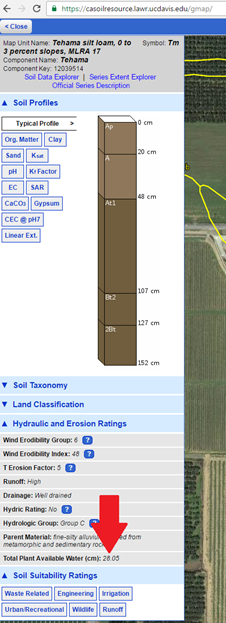Wet soils for extended periods after leaf out can result in yellow trees due to a cold root zone and low soil oxygen levels. Spring rains can be responsible for wet soils and yellow leaves; that can’t be avoided. However, irrigation – before it’s needed- also causes this problem and should be managed to keep root systems (and the crop they support) as healthy as possible.
Timing of first irrigation of the year is an important early season decision in orchard production. If irrigation is delayed too long and trees become water stressed, spur and shoot growth along with current and future yield may be reduced. If water goes on too soon in the season, before trees use much water, early irrigation can harm orchard health, as saturated soil conditions can be followed by root/crown Phytophthora infection and/or oxygen-starved roots. Roots systems stressed by early season saturated soil conditions may not be healthy enough to deliver the water necessary to meet tree needs in the summer. In addition, saturated soils are less warm than well-drained soils and this reduces nutrient availability and/or the rate of nutrient absorption by roots. Locally-variable spring rains can complicate irrigation planning, so timing of first irrigation requires careful attention.
The short answer is to irrigate when net soil water depletion is equal to the amount of water delivered in your first irrigation set or, put another way…
Water delivered in first irrigation set = Total, season-to-date orchard water use (ET) + Rainfall.
The timing of first irrigation varies from year to year depending on leaf-out date and weather conditions, including rainfall, so don’t use a calendar to time first irrigation. For the best possible timing for first irrigation, you need to know the following:
- How much plant available water will your soil hold after rainfall or irrigation? Ballpark estimates of this number can be found in the NRCS soil survey for your county or online. Ask your local UCCE Farm Advisor for advice on how to use this valuable publication. Look in the table containing “physical properties” (sometimes labeled “engineering properties”) to find the “Available water holding capacity” of the soil. If you are using the interactive version of the NRCS maps or GoogleEarth, click on the soil series name, then look under “Hydraulic and Erosion Ratings” to find total plant available water (cm)”. The SoilWeb app for iPhone and Android (available free from the App Store) also provides plant available water data.
- How much water are the trees using? Estimates of water use by tree crops in the Sacramento Valley are updated weekly during the summer. Water use is measured as acre inches of Evapotranspiration (ET) for mature trees. Water use by young trees can be estimated from canopy volume.
- How much water do you apply per hour or per set? If you are using a pressurized system – drip, micro-sprinkler, or impact sprinklers – the company that put in the system should have this information. You could also measure output in the field.

The tip of the red arrow shows where you can find Plant Available Water on the online soil maps. 2.54 cm = 1″
Here’s an example of how the information listed above fits together. Suppose:
- Your orchard soil holds 2.75” of plant available water in the root zone;
- Your irrigation system puts 1.215” of water in the soil (accounting for system efficiency*) per set;
- Since first leaf out, the orchard used 1.5″ of water based on ET estimates; and
- It rained 1.5” since leaf out. Use 0.75″ as the amount of rain that actually recharges the root zone (assume the rest is lost from the orchard as runoff).
Put on your first irrigation after the orchard has used at least 1.875” of water based on ET (using the equation above: ET = 0.75” rainfall + 1.215” water delivered in irrigation set). If you are using a micro-sprinkler system with 90% efficiency, apply 1.35 inches of water to deliver 1.215 inches to the soil profile. If you are using flood irrigation, your first irrigation should go on when plant available moisture in the rootzone is 50% depleted.
If spring weather is wet, consider applying a dry nitrogen (N) fertilizer in the herbicide strip ahead of forecast rain instead of fertigating. The rain will dissolve the fertilizer and move the N into the soil. This practice delivers N to the root zone without adding more water to saturated or near saturated soil. If using a fertilizer containing ammonium and/or urea, apply it as close to the start of rainfall as possible to avoid nitrogen loss by ammonia volatilization. An ammonium-only N source (for example, ammonium sulfate) will move the shortest distance into the soil from the soil surface (leach the least) with the rain (or irrigation) water that moves it into the soil compared to urea or nitrate.
*General guidelines for irrigation system efficiency (from Allan Fulton, UCCE Water Advisor): 80-95% efficiency for drip irrigation; 80-90% efficiency for micro-sprinkler irrigation; 70-85% efficiency for sprinkler irrigation.


Leave a Reply